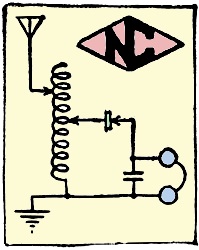National Company Advertisement: Modulation |
|
"It is anybody's guess as to what modulation system the amateur of 1975 will be using." That forward-looking line appeared in this 1947 QST magazine infomercial by the National Company. The writers probably had no real idea how different electronics would be 25 years in the future, especially since John Bardeen et al would not invent the transistor until two more months (December 1947) after the publication of this issue. In their traditional style, this full-page advertisement was heavy on text and light on images. The company invested in customer education with the hope being a well-informed and appreciative hobbyist would reward them with patronage. National Company Advertisement
The amateur might well wander how same of these newer communication techniques, such as Narrow Band Frequency Modulation, Narrow Band Phase Modulation, Frequency Shift Telegraphy, Pulse Time Modulation, Pulse Count or Pulse Code Modulation, Pulse Amplitude Modulation, Pulse Frequency Modulation, and Pulse Width Modulation will change the D.X. or V.H.F. picture. Will they complicate or simplify the apparatus involved? This is the stage of the game where predictions of things to come are many, and differ widely. Basically, there are some fundamental facts which can be applied to give a clearer understanding of the situation. Concerning A.M., F.M. and P.M., as the unmodulated carrier at the receiver becomes weaker it finally gets lost in the noise at a level governed by selectivity, and all three systems are equal in this respect. When the carrier is modulated it becomes readily apparent that the effectiveness of any one of these three systems far weak signal reception is determined by its ability to combat noise. A little investigation into the characteristics of noise shows that with tube hiss and thermal noise, the noise reaches an average value, but noise peaks or very short pulses are as much as 13 decibels (approximately) above the average level. Ignition noise and man-made static are of this character but often have a much larger ratio of peak-to-average value. As the R.F. signal level decreases toward the average noise level these noise peaks obliterate the R.F. signal for very short intervals of time and no type of modulation can be effective. Improvement in reception under these circumstances can then be obtained by techniques which will permit the receiver to. recover more rapidly after each paralyzing pulse of noise. If one system of modulation permits receiver designs which allow the receiver to recover more rapidly than another, that system will ultimately be superior in providing readability from a weak signal. Many practical factors enter the situation, such as complication or simplification of receiver or transmitter, cost of parts, bandwidth to be used, and last, but not least, reduction of broadcast interference, for a few examples. The F.C.C. in its recent order allowing narrow-band F.M. and P.M. within amateur phone bands for a one year period clearly indicates its desire to gather data on practical operating experience. National, developing components and producing equipments, will continue its efforts to help the amateur improve the art of radio. communication, and will have an announcement of interest to N.B.F.M. experimenters. The years have shown the amateur to be truly progressive and we expect to see "N.B.F.M. given a real tryout between now and August 1, 1948. W. A. Ready Here are all the National Company advertisements I have:
Posted May 13, 2022 |
|

 Radiotelephone communication used to be so simple
when all we had to contend with was amplitude modulation or A.M., plus unintentional
F.M. when the oscillator happened to be unstable. But now, just keeping abreast
of some of the new modulation techniques is a major project. It is anybody's guess
as to what modulation system the amateur of 1975 will be using.
Radiotelephone communication used to be so simple
when all we had to contend with was amplitude modulation or A.M., plus unintentional
F.M. when the oscillator happened to be unstable. But now, just keeping abreast
of some of the new modulation techniques is a major project. It is anybody's guess
as to what modulation system the amateur of 1975 will be using.